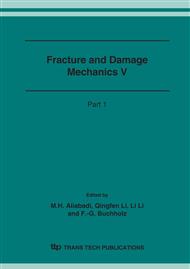p.39
p.43
p.47
p.51
p.55
p.59
p.63
p.69
p.73
A Numerical Method for Predicting the Time to Surface Cracking of Corrosion Affected RC Structures
Abstract:
Practical experience and observations suggest that corrosion affected reinforced concrete (RC) structures are more prone to cracking than other forms of structural deterioration. Concrete cracking incurs considerable costs of repairs and inconvenience to the public due to interruptions. This gives rise to the need for prediction of the time to surface cracking of concrete in order to achieve cost-effectiveness in maintaining the serviceability of RC structures. The intention of this paper is to develop a numerical method for predicting the time to surface cracking of corrosion affected RC structures. In this method, concrete with embedded reinforcing steel bars is modeled as a thick-wall cylinder. With an exponential curve modeling the energy dissipation process in concrete, the element transfer matrix is derived analytically. The time to surface cracking is then determined by solving the nonlinear problem numerically. Finally, the validity of this numerical method is verified by comparing with experimental results collected from the research literature.
Info:
Periodical:
Pages:
55-58
Citation:
Online since:
November 2006
Authors:
Price:
Сopyright:
© 2006 Trans Tech Publications Ltd. All Rights Reserved
Share:
Citation:


